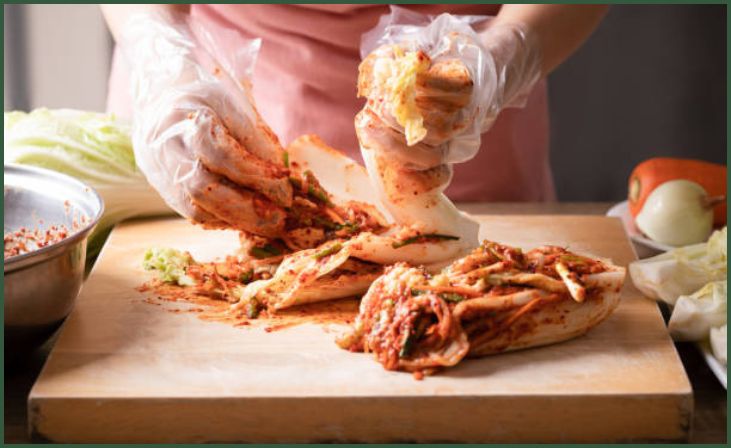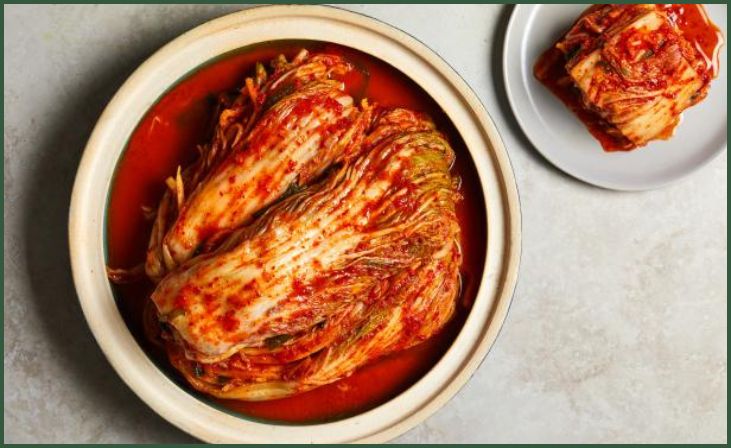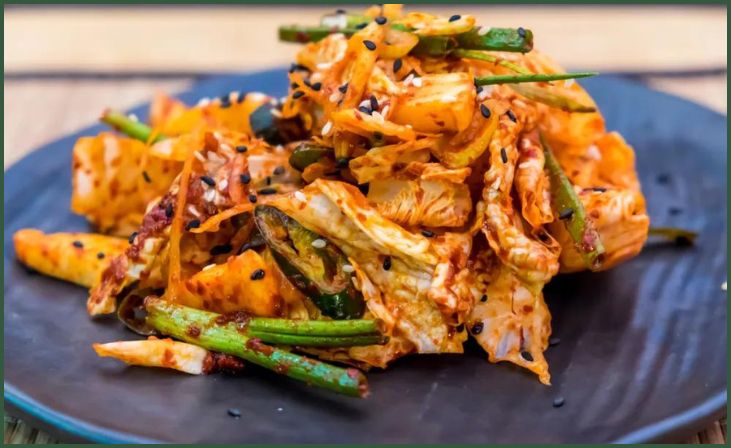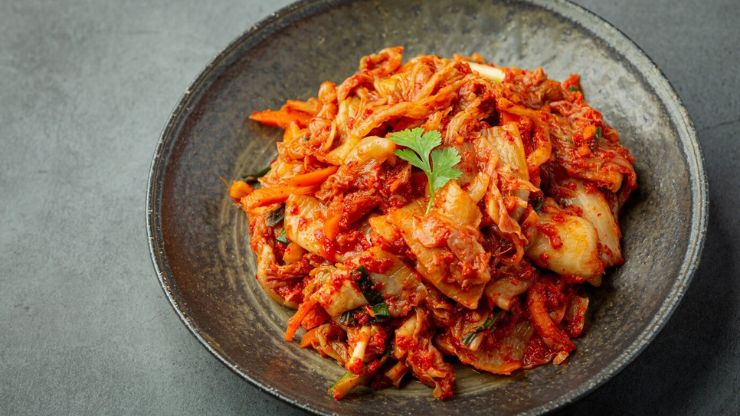Are you prepared to embark on a delightful culinary journey to craft a mouthwatering batch of Korean Kimchi? With our comprehensive step-by-step fermentation guide, you’ll swiftly gain the expertise you need. So, let’s take a plunge into the captivating realm of Korean Kimchi Recipe!
Korean Kimchi is not just a dish; it’s an art form, a labor of love that has been perfected over generations. The tantalizing blend of flavors, the balance of spiciness and freshness, and the explosion of taste in every bite make Korean Kimchi a culinary masterpiece. Whether you’re a seasoned chef or a novice in the kitchen, our detailed guide will lead you through the process, helping you master the art of crafting this iconic Korean delight.
But what exactly is Korean Kimchi, and why is it so revered in Korean culture? Let’s unravel the mysteries of this delectable dish together.
Table of Contents
ToggleKorean Kimchi Recipe With Step-By-Step Fermentation Guide
Gathering Your Ingredients

Before you embark on your Kimchi-making adventure, it’s essential to assemble the right ingredients. The following is a list of the things that you will require:
Napa Cabbage: The heart of any kimchi, Napa cabbage provides the crispness and base for your dish.
Also Read:- Preserving the Harvest for Winter
Sea Salt: This is used to season and soften the cabbage leaves, a crucial step in the fermentation process.
Korean Red Pepper Flakes (Gochugaru): Gochugaru lends the signature spiciness and vibrant color to Korean Kimchi.
Garlic: The aromatic and flavorful addition that enhances the depth of your kimchi.
Ginger: Ginger adds a hint of warmth and zest, complementing the other flavors.
Fish Sauce: This savory and umami-rich ingredient is essential for the classic taste of Korean Kimchi.
Sugar: A touch of sweetness balances the spiciness and enhances the overall flavor.
Carrots: Carrots provide a delightful crunch and a hint of natural sweetness.
Daikon Radish: This radish variety contributes a refreshing, crisp texture to your kimchi.
Green Onions: These add a burst of color and a subtle, oniony flavor to the mix.
Preparing Your Cabbage
The first step in creating your own Korean Kimchi masterpiece is to prepare the Napa cabbage. Here’s a step-by-step guide:-
Cut the Napa Cabbage into Quarters: Begin by cutting the Napa cabbage into quarters. This allows for easier handling and ensures the seasoning reaches every leaf.
Sprinkle Sea Salt Between the Cabbage Leaves: Once quartered, generously sprinkle sea salt between the leaves. This serves to season the cabbage and initiate the wilting process.
Don't just scroll, subscribe!
BuzzTrail's unique web-stories are the cure for boredom you've been waiting for.
Let it Sit for a Few Hours to Wilt and Soften: After applying the sea salt, let the cabbage sit for a few hours. This allows it to wilt and soften, making it more pliable for the next steps. Keep reading to know more about Korean Kimchi Recipes.
Korean Kimchi Paste

Creating the perfect kimchi paste is a vital component in achieving an authentic taste. Here’s how to make it:
Combine the Following Ingredients in a Blender:
- Korean Red Pepper Flakes (Gochugaru)
- Garlic
- Ginger
- Fish Sauce
- Sugar
Blend Until You Have a Smooth, Vibrant Red Paste: Blend these ingredients until they form a smooth, vibrant red paste bursting with flavor. This paste will be the heart and soul of your kimchi.
Assembling Your Kimchi
With the kimchi paste ready, it’s time to assemble your kimchi:
Rinse the Salted Cabbage Under Cold Water and Drain: After the cabbage has wilted, rinse it under cold water to remove excess salt and then drain it thoroughly.
Generously Coat Each Cabbage Leaf with the Kimchi Paste: With the cabbage prepared, generously coat each leaf with the flavorful kimchi paste. Make sure to get an even distribution.
Add Carrots, Daikon Radish, and Green Onions for a Burst of Color and Texture: Enhance your kimchi with the addition of carrots, daikon radish, and green onions. These ingredients not only add color but also bring varying textures and flavors to your dish. Continue scrolling through to know more about the Korean Kimchi Recipe.
Fermentation Process
Fermentation is where the true magic of Korean Kimchi occurs. Here’s what you need to do:
Place Your Kimchi in an Airtight Container: Transfer your kimchi into an airtight container, ensuring there’s minimal exposure to air.
Allow it to Ferment at Room Temperature for a Day or Two: Let your kimchi ferment at room temperature for a day or two to kickstart the process.
Store it in the Refrigerator for a Longer Fermentation Period: For a more extended fermentation period, move the container to the refrigerator. The longer it ferments, the bolder and more intense the flavors will become.
Also Read:- How Does Alcohol Fermentation Work
Serving and Enjoying

Once your kimchi has achieved your desired level of fermentation, it’s time to savor and appreciate the fruits of your labor. Korean Kimchi is an incredibly versatile ingredient and can be used in various dishes, from enhancing the flavors of Korean barbecue to adding depth to soups and stews. So, serve it up and enjoy the explosion of flavors that is Korean Kimchi!
Conclusion
In the world of culinary delights, few dishes can compare to the complexity and richness of Korean Kimchi. What started as a simple preservation method has evolved into a global sensation, celebrated for its bold flavors, health benefits, and cultural significance. With our step-by-step fermentation guide, you’ve unlocked the secrets to creating this beloved Korean dish in your own kitchen.
As you’ve learned, the journey begins with gathering the right ingredients, each one playing a crucial role in the symphony of flavors that is Korean Kimchi. Napa cabbage provides the foundation, while sea salt, Korean red pepper flakes (Gochugaru), garlic, ginger, fish sauce, sugar, carrots, daikon radish, and green onions form the orchestra of taste and texture. With these in hand, you’re ready to embark on a culinary adventure.
The process involves more than just mixing ingredients; it’s a labor of love. From the careful preparation of the cabbage, allowing it to wilt and soften, to the creation of the vibrant and aromatic kimchi paste, you’re weaving together a tapestry of flavors that will leave your taste buds dancing.
FAQs
Can I adjust the spice level of my kimchi?
Can I adjust the spice level of my kimchi?
Absolutely! You can control the spiciness by adjusting the amount of Korean red pepper flakes (Gochugaru) in your paste.
How long does it take for kimchi to ferment?
How long does it take for kimchi to ferment?
The fermentation time can vary. It’s typically ready for consumption within a few days, but you can continue fermenting it for a more robust flavor.

